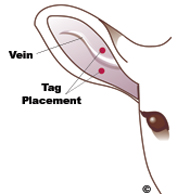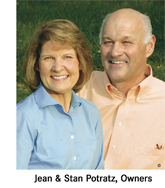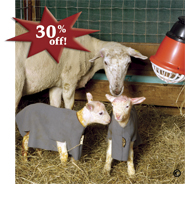Message from the Owner
Hair Sheep at PremierThat's right. Hair sheep. In the last few months Premier purchased "starter flock" hair ewes, ewe lambs and rams for our farms. The breeding-Dorper/Romanov and Katadin. It's our intent to expand their numbers to several hundred head over next few years. The ReasonsWhy? We expanded our land base from 100 usable acres on 1 farm to 360 on 3 farms. The extra land, by type and terrain, is grazing land with miserable fences and minimal buildings. So we need more animals. And it's an opportunity to expand our field trials of fences and equipment. Why not just triple the size of our existing flock (primarily Border Leicester with some Ile de France, Dorper and Romanov)? Their genetics are such that to be productive they need to be exposed to the rams in Oct. or Nov. and lambed indoors. 1) We don't have buildings for up to 800 ewes. 2) It's exhausting work. 3) I can't hire extra people to spring lamb that many sheep indoors. What makes us think that hair sheep exposed in Dec. to lamb in May outside on the pasture will be more productive? Extensive research at MARC (Meat Animal Research Center) in Nebraska by K. Leymaster and M. Wallace. I've known these fellows personally for 25 years. I trust their work. It suggests that mature Dorper/Romanov ewes will wean a 190% lamb crop if allowed to lamb outside with minimal human intervention in May in the High Plains. We're going to "farm-test" this production model in SE Iowa. We will report our results via this newsletter. What rams will Premier use on the ewes? Eventually we will use large terminal sires (Suffolk, Hampshire, Columbia or similar) to produce a lamb that finishes above 120 lbs. That's the commercial lamb production model in the Midwest USA that fits today's high labor costs, moderate lamb prices, high feed costs & high land costs. But we need more ewes. So for the first years we will use Dorper/Romanov rams. We're even using them on a portion of our existing flock. Isn't it a fact that lamb buyers will not pay as much for finished hair lambs? For direct marketing and for your own table hair lambs are probably worth more (the meat is often milder in taste). But the pelt from 100% hair lambs is worth nothing to a commercial lamb buyer-so� the lamb will be discounted by the larger buyers. We're told that lambs that are 50% hair genetics do not encounter the same discount. We'll see. Will stocking hair sheep and wool sheep on the same property reduce the value/lb. of the wool? It will. The loose hair when they shed their winter coat will contaminate the fleeces of wooled sheep. But that's true here now from our goats, horses and cattle. So the minimal loss in value is more than offset by more lbs. of lamb with less labor. Didn't Premier already experiment with Dorper and Romanov rams? Yes. When bred to our existing genetics the resultant ewe did not work well-had to shear them; got too fat (if 1/2 Dorper); hard to lamb indoors, flighty (if 1/2 Romanov). Not a good cross in our view. Will we like a Dorper/Romanov or a Katahdin ewes better? That depends upon temperament, foot issues, parasites, growth rate, labor hrs/per lamb sold, etc.by Stan Potratz Special Price from Premier!
30% Off
|
 |
Livestock Guardian Dogs
by Suzanne W. Gasparotto
Wherever you live and raise goats, your livestock needs protection from predators. Livestock Guardian Dogs (LGD) have been bred for hundreds and even thousands of years to provide this necessary function. From bears in the northwest USA to coyotes in Texas to packs of roaming domestic dogs in suburban and urban areas, Livestock Guardian Dogs are the best predator protection available. Other types of livestock guardian animals cannot see as well at night and don't seek out predators with their sense of smell like livestock guardian dogs do.
There are many breeds and sub-breeds of Livestock Guardian Dogs. Anatolian Shepherd, Great Pyrenees, Komandor, Maremma, Ovtcharka, Karst, Tatra, and Kuvasz are a few of the most recognizable LGD's in this country. All breeds perform their jobs similarly, with subtle differences between them. Some mature faster intelligence-wise, others have long coats adapted for comfort in very cold climates, while some breeds are more even-tempered. This writer prefers the Anatolian Shepherd because of its short hair (perfect for hot, dry, thorn-infested West Texas), its sunny disposition, and its early mental maturity. Anatolians are smarter than most people you'll ever meet.
The Livestock Guardian Dog is stubborn, single-minded, and focused solely on its herd and its protection. We Texans call this characteristic "hard-headedness." Livestock Guardian Dogs are often not especially social animals, tending instead to stay with the goat herd. Although some folks manage to make pets and companion animals of them, their "alpha" nature does not particularly suit them for this role. They should never be left unsupervised with children, pets, or livestock other than those which they are guarding.
It is critical that you work with the dog and socialize it to you so that it is manageable. If you have dogs, cats, poultry, or other livestock, you must be careful with the introduction of the LGD to these animals. Unless the Livestock Guardian Dog is taught otherwise, all other animals, even other Livestock Guardian Dogs, are enemies to its livestock. A LGD puppy raised with your pets and other livestock generally provides the best opportunity to have them all get along. There are drawbacks to beginning with a puppy, particularly if predators are a current problem. A puppy isn't ready to handle predators on its own and won't be until it is about eighteen (18) months old.
LGD's work best in pairs. A male-female pair, at least one of which has been neutered or spayed, works well together. An older dog works well with a younger, less-experienced animal, teaching the pup how to refine its instincts. Do not run two unspayed females or two intact males together. When one of them comes into heat, fights will occur. It is dangerous to physically get between two fighting LGD's. To separate two fighting dogs, use the strong spray from a water hose. Do not put yourself between them or you will need medical attention.
Livestock Guardian Dogs are sensitive animals -- the ability to sense what is happening makes them good at their jobs. Don't shout at them and never strike them with any object, including your hand. Speak calmly and slowly when instructing or correcting the actions of the LGD. You must at all times be the 'alpha' -- the dominant one -- in the relationship. Take a misbehaving LGD by the scruff of the neck and turn it upsidedown on the ground to indicate to the dog that you are in control. Ninety-nine percent of the dog's activities will be the result of instinct bred into it. That other 1% can make or break its effectiveness, and that is where the 'alpha' human's role is critical.
LGD's are big animals. They grow fast, often achieving weights of over 100 pounds in 12 months or less. Their bodies mature faster than their minds, so remember that you will have a very large puppy on your hands for some time. Livestock Guardian Dogs under eighteen months of age should work in tandem with an older LGD. Don't be alarmed when the adult Livestock Guardian Dog goes up to each goat in its newly-acquired herd and licks or gently paws its face. This is normal get-acquainted behavior. Newly-acquired weaned puppies should be put in a pen separate from but adjacent to goats before being introduced into a goat herd. After several weeks of this arrangement, carefully introduce the young LGD into a small group of goats in a location where the producer can monitor all activities. Don't put pups in with juveniles under a year of age, kids, pregnant does, or does that are nursing kids. Don't put multiple puppies in with the same group of goats; their rough-housing will wind up hurting some goats. Put a pup with an older experienced LGD who is assigned to a herd of mature bucks or does. The pup needs to get banged around a bit by the bigger goats for him to learn his place in the pecking order.
The biggest challenge facing most LGD owners is making sure that the dogs get properly fed. The Livestock Guardian Dog thinks of itself as one of the goats in the herd. In fact, the dog will assume a subservient place in the herd and will sometimes give up its food to its goats. Some Livestock Guardian Dogs will eat goat food at the trough with the goats it is guarding and will at times even try to eat hay. Obviously, this nutritional level is much too low for a canine. Establish a location where the dog can eat undisturbed by the livestock, and feed the dog at the same time that the goats are fed. Don't be surprised if the LGD eats one day, then skips eating for several days. Livestock Guardian Dogs tend to eat like wolves . . . gorging when food is plentiful to hold them over until the next meal is available. This is instinct-in-action.
Some LDG's (Anatolian Shepherd comes to mind) have a body build similar to that of a Greyhound . . . long & lanky. It always looks like it needs to gain weight. Any animal which can run 35 to 40 miles per hr. has to be lithe of build.
The LGD often looks like it is doing nothing. Don't be fooled. The LGD is always on watch. During the daylight hours, the dog will be hard to find and, if located, will appear to be sleeping. In fact, it is resting and watching everything. Two or three dogs working together will be spread out around the pasture at strategic points and inconspicuous to all but those who know how to look for them. Introduce a strange animal, person, or object into that pasture and watch what happens. A huge ruckus ensues as the dogs make their presence known by calling out to the intruders & to each other. This writer has observed one of her LGD's become suddenly upset by the presence of a spider underneath a board in the back of the goat shelter. The spider was hard to find and barely visible, but the dog saw it and didn't like its being there.
Nighttime is when the Livestock Guardian Dog becomes active, vocal, and really goes to work. As dusk approaches, the dogs begin to call out to each other and to predators. The LGD has sounds for each situation; when predators are around, it makes a distinctly recognizable bark that is quite different from the sounds made when the goat producer comes with feed or when a goat is down. Specific sounds are vital for protecting the herd from predators. LGD's are barking machines. If the sounds of dogs barking all night bothers you or your neighbors, then Livestock Guardian Dogs are not for you. Some LGD's are guarders and some are patrollers; the goat producer won't know the difference until he observes the dog at work. A patroller does not become a guarder easily if at all. Patrollers need acreage over which to roam. Patrollers don't know your goats from your neighbors' goats -- they are all goats in need of his protection.
If you are on small acreage or in a semi-urban or suburban area, predator protection other than Livestock Guardian Dogs may be your best choice. Although this writer has no experience with the product, the NiteGuard solar-powered predator light has been reported by some goat producers to be the solution to their predator problems on small acreage or in suburban areas where "patroller" LGD's will not stay home. Check the product out for yourself at www.niteguard.com. Price is under $50.00 per light. If none of these options works for you, ask a male family member to walk the perimeter of your property & urinate along the fence line and on the wooden fence posts. Predators rely on their sense of smell; unfamiliar smells cause them to shy away. Can't hurt & might help. This is not a joke.
Behavioral traits of Livestock Guardian Dogs can be confusing to people unfamiliar with them. Example: A doe gives birth in the pasture & the kid is stillborn or dies. To protect the rest of the goats, the LGD will eat the dead kid so that predators are not drawn to the herd. It would be easy to misinterpret this situation as one in which the dog killed the kid, when in fact that is not the case. Another example: The Livestock Guardian Dog will stay with a sick or lame animal and sometimes appear to be harassing it, when in fact the LGD is trying to separate it from the herd for the herd's overall protection, or the dog will force the downed goat to move towards its herd for protection. A good LGD will sense if the goat is dying or has a good chance to survive.
Livestock Guardian Dogs are independent and self-sufficient. They can survive for days in pasture conditions with their goats. They will catch and eat rabbits, squirrels, and other small animals -- but it is always necessary to provide dog food for them. LGD's should be vaccinated against rabies, parvo, distemper, and other serious diseases annually since their exposure to these diseases is high. They seldom sleep under shelter. Indeed, Livestock Guardian Dogs do not need us. It is WE that need THEM.
The above article was first published in Goat Rancher Magazine for which Suzanne writes exclusively. You can contact her at:
Suzanne W. Gasparotto
HC 70 Box 70, Lohn, TX 76852
325-344-5775
www.tennesseemeatgoats.com
onioncrk@centex.net
Premier Tip
 |
How to Reduce Ear Tag Losses
(drawing at right) For maximum retention & the lowest risk of bleeding & infection, place ear tags in either of the 2 red spots. (One piece loop tags only fit in the lower red spot.) Avoid the large vein. The goal is about 2" from the head of sheep.
- Insert the tag 1-2 inches from the skull where the ear tissue is thicker and is more difficult to tear. Also tags placed close to the head rarely snag in wire, brush, hay, or grass.
- Avoid the large veins in the ear. If damaged, they heal slowly and can become infected.
- Place the female portion of the tag on inside of the ear.
- Avoid double button tags for sheep/goats.
- Avoid low fiber diets. Lambs on high grain and liquid diets crave to chew on anything—including tags.
For more Premier ear tag information and products click here.
Premier Employee Spotlight
 |
Julie Glaspie
Sporting a friendly smile and positive attitude, Premier's feature employee Julie Glaspie is no stranger to work. Julie heads up the repairs, sharpening and returns department at Premier. She appreciates the opportunity to do something different each day. "Work is never boring and there are always new and exciting challenges."
When asked what she likes most about Premier, Julie mentions the people she works with and for. Watching Premier grow over the years has been an added bonus.
Julie's family includes Jim, her partner for 7 years; her son, Derek, who is currently serving in Iraq; and her daughter Devyn who recently graduated from high school. Her cats, (Turbo and Emmitt) and dog (Parker) are also considered part of the family.
In her free time Julie loves basketball, playing cards and bowling (an impressive 150 average). As if she wasn't busy enough, she also works at a supermarket (Hy-Vee).
Julie lives by the quote, "God doesn't give you more than you can handle." "I always tell myself (and kids) this when life gets tough." A true team player and hard worker defines Premier's Julie Glaspie.
Recipes
Rosemary Lamb Chops
Ingredients:
2 tsp. oil
8 lamb loin chops (1 lb.)
1 small onion, chopped
3/4 cup roasted red peppers drain & chop
1/4 cup beef broth
1/4 cup balsamic vinaigrette dressing
1/2 tsp. chopped fresh rosemary
Heat oil in large non-stick skillet on medium-high. Add chops; cook 6 min., turning after 3 min. Remove from skillet; cover to keep warm.
Add onions to same skillet. Cook 5 min. or until onions are tender, stirring occasionally. Stir in peppers, broth, dressing and rosemary. Add chops. Reduce heat to medium-low; simmer 4 min.
Hot Apple Cider
Ingredients:
1 - 64 oz. bottle apple cider
3 cinnamon sticks
1 tsp. whole allspice
1 tsp. whole cloves
1/3 cup brown sugar
In a slow cooker, combine apple cider and cinnamon sticks. Wrap allspice and cloves in a small piece of cheesecloth, and add to pot. Stir in brown sugar. Bring to boil over high heat. Reduce heat and keep warm.



